Pipalya
White Pass, SAR (South Australian Railways)
This thread is about the "Garden" in Garden Railway, specifically the PMES Garden Railway which is located in Penfield, a suburb of Adelaide, South Australia.
It is also being posted on the "other blog" so those in other countries can become aware of us and might visit us if ever they are in the neighbourhood.
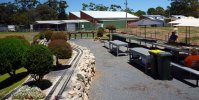
In it's present site the garden has existed since 2015.
At the beginning it was quite bare, but since then many trial and error plantings has converted it into a real garden.
The rough rule of thumb for the plantings is that:
1. they shouldn't detract from the viewing of the trains
2. large plants should attempt to convey a scale appearance of trees.
3. they should be hardy to minimise maintenance.
This hasn't always been easy to achieve.
Some of the plants grow too large too quickly.
Some plants depend on dripper or spray irrigation to survive our hot dry summers
Some plants don't convey the image of trees at all.
Some plants end up blocking the view of the tracks.
Not all of this is bad.
However to achieve the appearance of trees to scale
it has been found that we needed to apply some of the
bonsai techniques to limit growth and enhance appearance
and we may need to remove "inappropriate" plants.
The main species that have been successful have been:
Malaleuca linariifolia dwarf "Claret Tops"
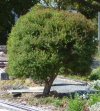
Buxus sempervirens - English Box
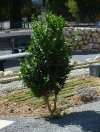
Westringia fruticosa - Grey Box
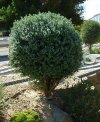
Myrtus communis 'compacta' Dwarf Myrtle
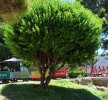
All of these have required "bonsai treatment".
This may include:
1. planting in a pot in the ground which is rotated from
time to time to restrict root growth.
2. pruning foliage and removing limbs to shape the 'tree'.
In addition other plantings such as ground covers and succulents
have added to the appearance of the 'country' and latterly some colour
on the rock faces.
All of this seeks to enhance the visitor's experience of a miniature
railroad on our regular open days.
Visit the web site for further information.
Future posts will include photos illustrating some of the points raised above.
It is also being posted on the "other blog" so those in other countries can become aware of us and might visit us if ever they are in the neighbourhood.

In it's present site the garden has existed since 2015.
At the beginning it was quite bare, but since then many trial and error plantings has converted it into a real garden.
The rough rule of thumb for the plantings is that:
1. they shouldn't detract from the viewing of the trains
2. large plants should attempt to convey a scale appearance of trees.
3. they should be hardy to minimise maintenance.
This hasn't always been easy to achieve.
Some of the plants grow too large too quickly.
Some plants depend on dripper or spray irrigation to survive our hot dry summers
Some plants don't convey the image of trees at all.
Some plants end up blocking the view of the tracks.
Not all of this is bad.
However to achieve the appearance of trees to scale
it has been found that we needed to apply some of the
bonsai techniques to limit growth and enhance appearance
and we may need to remove "inappropriate" plants.
The main species that have been successful have been:
Malaleuca linariifolia dwarf "Claret Tops"

Buxus sempervirens - English Box

Westringia fruticosa - Grey Box

Myrtus communis 'compacta' Dwarf Myrtle

All of these have required "bonsai treatment".
This may include:
1. planting in a pot in the ground which is rotated from
time to time to restrict root growth.
2. pruning foliage and removing limbs to shape the 'tree'.
In addition other plantings such as ground covers and succulents
have added to the appearance of the 'country' and latterly some colour
on the rock faces.
All of this seeks to enhance the visitor's experience of a miniature
railroad on our regular open days.
Visit the web site for further information.
Future posts will include photos illustrating some of the points raised above.
Last edited:
